
Return to Gallery
Display Contents
Beaker burials of Thanet - Part 1:
A Gazetteer of Thanet Beaker burials
Cliffsend
St. Peter's
*Northdown
**Milmead
Manston
Cottington
South Dumpton Down
Monkton-Minster
Monkton-Minster
Monkton-Minster
Monkton-Minster
Chalk Hill Ramsgate
***Ramsgate
North Foreland
QEQM Margate
Scales in centimetre divisions
A Gazetteer of Thanet Beaker burials
By the end of 1994 work by
Len Jay of the Thanet Archaeological Society (Jay 1995) had
identified a total of ten complete or near
complete Beakers which had been recovered from burial contexts in
Thanet. Since
then others have been found at Chalk Hill, North Foreland,
A list of known
Beaker burials from Thanet is presented
below. The list contains
information on the Beaker type, date of discovery and accompanying
finds with additional notes on the
burial where it is available.
Some entries have links to more
comprehensive accounts of each site and it is hoped to add more in the
near future as time and opportunity permits.![]()
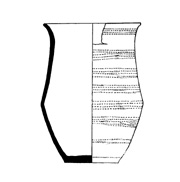
By Nigel Macpherson Grant
A 'Bell-shaped',
Found in a grave disturbed during the cutting of a drainage trench at Cliffview Road, Cliffsend. The grave was 'six feet... cut two feet into the natural chalk'. Only the Beaker and some fragments of leg bone were recovered. There were no traces of a barrow.
The Beaker was subsequently destroyed in a fire at Ramsgate library.
NGR TR 3457 6481.
TSMR 170.
Macpherson Grant 1968; Jay 1995.
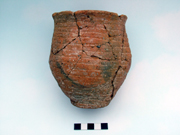
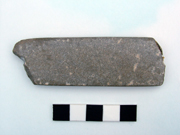
(II)
St. Peter's Refuse Tip 1969/71.
Excavation led by A.C. Hogarth.
Clarke's (1970) East Anglian style Beaker; Lanting and Van der Waals' (1972) Step 2 or 3.
From a disturbed grave which had been cut ('a little above the skeleton's waist') by a later roundbarrow. No contemporary burials are reported from the roundbarrow, but it became the focus for a subsequent Anglo-Saxon cemetery.
Clarke's (1970) East Anglian style Beaker; Lanting and Van der Waals' (1972) Step 2 or 3.
From a disturbed grave which had been cut ('a little above the skeleton's waist') by a later roundbarrow. No contemporary burials are reported from the roundbarrow, but it became the focus for a subsequent Anglo-Saxon cemetery.
Accompanied by a stone wristguard of Atkinson's B1 type (Clark 1970), with two centralised hour-glass perforations at either end.
NGR 637487 169300 (approximate).
Gibson *; Jay 1995; Minter and Herbert 1973.
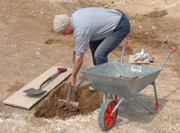
Excavation led by Brian Philp, Kent Archaeological Rescue Unit.
Beaker type unknown; possibly from a barrow. No further details published.
B. and E. Philp 1975; Jay 1995.
Recent information suggests that the 'fine pottery Beaker' mentioned in the source text may actually have been a small Collared Urn, having little or no decoration.
It is hoped to add more information to this entry in the near future.
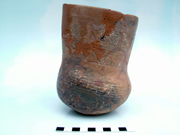
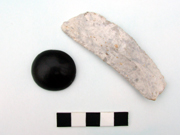
Excavation led by David Perkins, Thanet Archaeological Unit; (MRA87).
Clarke's (1970) Southern 2 type Beaker; Lanting and Van der Waals' (1972) Step 5/6.
From a chalk-cut grave within a roundbarrow, containing a crouched inhumation burial; radiocarbon-dated to 2120-2080 BC (68%) or 2132-1922 BC (68%)* / 2140 - 1885 BC (95%); (BM-2642). The body was that of a slightly built adult, laid on their left-hand side, facing east; probably within a wooden coffin-structure. The Beaker was laid behind their back.
Also accompanied by a 'V'-perforated jet button and a plano-convex flint knife recovered from the fill just above the skull. Both items were found away from the body.
The grave had been disturbed in antiquity. A pot sherd and fragments of long-bone unrelated to the first burial were also found, suggesting a later infill (perhaps during a robbery). Certain features of the grave also suggest the existence of a second burial (itself disturbed) superimposed upon the first, possibly during the Anglo Saxon period.
NGR 635150 165220.
TSMR 208.
Jay 1995; Perkins and Gibson1990; Perkins 1999.
* The dates 2120-2080 and 2140-1885 BC are listed in Perkins 1999; the date 2132-1922 BC is published in Perkins and Gibson 1990.
This Beaker is illustrated in Alex Gibson's book ‘Prehistoric pottery in
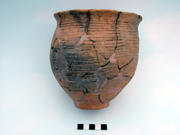
Excavation led by David Perkins,
Trust for Thanet Archaeology; (CLE90).
Clarke's (1970) East Anglian Group Beaker; Lanting and Van der Waals' (1972) Step 3.
From a flat-grave crouched burial cut by a Roman foundation. The burial was radiocarbon-dated to 2130-2075 or 2045-1930 BC (68%) / 2195-2155 or 2145-1880 (95%); (BM-2725).
The body was laid on its left-hand side, facing north. The remains were of an adult of slight stature, probably middle aged. The Beaker was positioned in front of the face.
TSMR 314.
Jay 1995; Perkins 1990; Perkins 1992.
Clarke's (1970) East Anglian Group Beaker; Lanting and Van der Waals' (1972) Step 3.
From a flat-grave crouched burial cut by a Roman foundation. The burial was radiocarbon-dated to 2130-2075 or 2045-1930 BC (68%) / 2195-2155 or 2145-1880 (95%); (BM-2725).
The body was laid on its left-hand side, facing north. The remains were of an adult of slight stature, probably middle aged. The Beaker was positioned in front of the face.
TSMR 314.
Jay 1995; Perkins 1990; Perkins 1992.
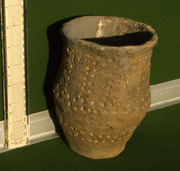
Photo by
Dave Perkins or Len Jay
(V)
South Dumpton Down 1992.
Excavation led by
David Perkins,
Trust for Thanet Archaeology; (SDD92).
Clarke's (1970) Mid Rhine Group Beaker; Lanting and Van der Waals' (1972) Step 3. Unusual decoration, with possible connections to the Netherland's 'Potbeker' tradition (Alex Gibson pers comm. in Jay 1995).
Clarke's (1970) Mid Rhine Group Beaker; Lanting and Van der Waals' (1972) Step 3. Unusual decoration, with possible connections to the Netherland's 'Potbeker' tradition (Alex Gibson pers comm. in Jay 1995).
From a central grave complex within a roundbarrow, containing the remains of seven individuals, some crouched, with others disarticulated and laid in varying orientations. The Beaker was most closely associated with an infant (Burial 4; facing west), but may alternatively have accompanied an adult (Burial 6; facing south-east). Both of these individuals were laid on their left-hand sides.
At the base of the intercut graves below the 'Early style' Beaker (Gibson), were sherds of a Food Vessel. Such an association between Beakers and Food vessels is rarely encountered in burials. Alex Gibson notes that Food Vessels themselves are rare in Southern England and rarer still in Kent (Perkins 2004). A total of three are now known, two of these are from Thanet.
Other examples of burials with similar characteristics are said to only be known from
No radiocarbon dates were obtained from burials 4 and 6; however others were obtained from burials 1, 3 and 5 and these are shown below:
Burial 1:
2120-2080 BC (68%) / 2135-1895 BC (95%).
(BM-2975).
Burial 3:
2020-2000 BC (68%) / 2100-2085 BC (95%).
(BM-2940).
Burial 5:
1920-1870 BC (68%) / 1965-1745 BC (95%).
(BM-2864).
NGR 639288 166333.
TSMR 606/857.
Fisk 2003; Jay 1995; Perkins 2004.
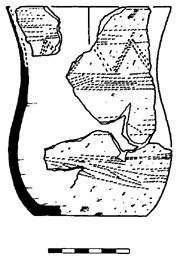
By Alex Gibson, for
Canterbury Archaeological Trust
(VI) Monkton-Minster
A253 1993.
Excavation led by David Perkins, Trust for Thanet Archaeology (Evaluation Phase)
Clarke's (1970) Primary Southern British Group (S1) Beaker; Lanting and Van der Waals' (1972) Step 3 or 4.
From a flat-grave containing a main burial and selected, disarticulated bones of three individuals, probably an adult female and two children (one aged about two years). The disarticulated remains were radiocarbon dated to 2289-1925 BC.
Excavation led by David Perkins, Trust for Thanet Archaeology (Evaluation Phase)
Clarke's (1970) Primary Southern British Group (S1) Beaker; Lanting and Van der Waals' (1972) Step 3 or 4.
From a flat-grave containing a main burial and selected, disarticulated bones of three individuals, probably an adult female and two children (one aged about two years). The disarticulated remains were radiocarbon dated to 2289-1925 BC.
The articulated inhumation was a male, laid on his right-hand side, facing east. Radiocarbon dated to 2130-2075 or 2045-1950 BC (68%) / 2180-2165 or 2145-1885 BC (95%); (BM-2898). The Beaker (fragmented and one third complete) accompanied the main burial and was placed in front of the head. The grave may have contained a wooden coffin-structure. Area 4; Grave 751.
Peter Clark pers comm.
Jay 1995; Clark forthcoming.
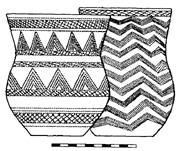
By Alex Gibson, for
Canterbury Archaeological Trust
Only one of these two Beakers is from this grave
(VII) Monkton-Minster
A253 1993.
Excavation by Canterbury
Clarke's (1970) Late Northern British Beaker Group (N3); Lanting and Van der Waals' (1972) Step 5.
This Beaker was found in a flat-grave, possibly in a wooden coffin-structure, which contained the remains of two adolescents. In the southern half lay a crouched inhumation, probably a female 12-14 years old, facing east.
Clarke's (1970) Late Northern British Beaker Group (N3); Lanting and Van der Waals' (1972) Step 5.
This Beaker was found in a flat-grave, possibly in a wooden coffin-structure, which contained the remains of two adolescents. In the southern half lay a crouched inhumation, probably a female 12-14 years old, facing east.
A second burial, positioned at the northern end, may be a later addition. This also may have been laid within a wooden coffin-structure. The body was that of a child aged less than 6 years, probably facing east. The Beaker was placed just north of their head. No associated radiocarbon-date. Around one wrist was a copper alloy 'Snake-head' type bracelet. Area 4; Grave 6371.
Peter Clark pers comm.
Jay 1995; Clark forthcoming.

By Alex Gibson, for
Canterbury Archaeological Trust
Only one of these two Beakers is from this grave
Excavation by Canterbury
Archaeological
Trust.
Clarke's (1970) S4 Group; Lanting and Van der Waals' (1972) Step 7. Although relatively common along the Eastern British seaboard and Central Southern England, this may be the first recorded example from Kent (Clark forthcoming).
Found in the northern end of a shallow and heavily truncated flat-grave. These lay amongst the disturbed and eroded fragments of bone which probably represent the crouched burial of a juvenile. Radiocarbon-dates of 1860-1850 and 1760-1520 BC are considered insecure 'and should be discounted' (Clark forthcoming).
Evidence of erosion suggests the grave may have been open for some time prior to the interment. Area 4; Grave 537.
Peter Clark pers comm.
Jay 1995; Clark forthcoming.
Clarke's (1970) S4 Group; Lanting and Van der Waals' (1972) Step 7. Although relatively common along the Eastern British seaboard and Central Southern England, this may be the first recorded example from Kent (Clark forthcoming).
Found in the northern end of a shallow and heavily truncated flat-grave. These lay amongst the disturbed and eroded fragments of bone which probably represent the crouched burial of a juvenile. Radiocarbon-dates of 1860-1850 and 1760-1520 BC are considered insecure 'and should be discounted' (Clark forthcoming).
Evidence of erosion suggests the grave may have been open for some time prior to the interment. Area 4; Grave 537.
Peter Clark pers comm.
Jay 1995; Clark forthcoming.
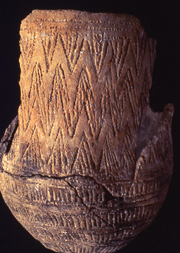
Canterbury Archaeological Trust
Clarke's (1970) Final Southern British Beaker Group (S4); Lanting and Van der Waals' (1972) Step 6.
From a flat-grave, possibly holding a wooden coffin-structure, containing a reported S2 Beaker (laid on its side) and a copper alloy bracelet of square section.
No skeleton survived.
The position of the artefacts suggest the burial was crouched, with the head to the west and the Beaker at its feet. Monkton roundabout; Area 9; Grave 3035
Peter Clark pers comm.
Jay 1995; Clark forthcoming.
(X)
Chalk Hill, Ramsgate 1997/8.
Excavation by Canterbury
A Beaker of unknown type, from the north-south aligned central burial of a roundbarrow. The grave contained a single crouched inhumation with a jet belt-ring and a fragmented but largely complete Beaker.
A possible secondary burial was found in a smaller pit. It contained fragments of a human juvenile accompanied by a bovine juvenile.
NGR 636190 164444.
Shand 2002.
Excavation by Canterbury
A Beaker of unknown type, from the north-south aligned central burial of a roundbarrow. The grave contained a single crouched inhumation with a jet belt-ring and a fragmented but largely complete Beaker.
A possible secondary burial was found in a smaller pit. It contained fragments of a human juvenile accompanied by a bovine juvenile.
NGR 636190 164444.
Shand 2002.
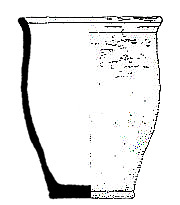
Kent Archaeological Rescue Unit
(***) Ramsgate 2000.
Excavation led by Brian Philp, Kent Archaeological Rescue Unit.
The ‘Beaker’ vessel is unusual, being undecorated and described as coarse, crude and hand-made, with a marginal ‘S’-shaped profile (205mm high, generally 10mm thick). The shape is similar to some ‘Early’ Beaker forms, however the date of the vessel is suggested as 1800-1300 BC. It was not examined by the pottery specialist who's analysis of the remainder of the ceramics was published in the report.
Discovered with the crouched burial of a young adult female within a roundbarrow. The skeleton was laid on her left hand side, facing east. The pot was placed behind her back.
NGR 638957 166148.
Philp and Chenery 2002.
Undecorated Beakers are rare; Clarke's 1970 survey lists none in Kent. The identification of this vessel as a ‘Beaker’ (with all that the term implies) might be debatable for now. This does not diminish the importance of the vessel however, for an Early Bronze Age pottery grave-good is actually a much rarer find on Thanet.
Excavation led by Brian Philp, Kent Archaeological Rescue Unit.
The ‘Beaker’ vessel is unusual, being undecorated and described as coarse, crude and hand-made, with a marginal ‘S’-shaped profile (205mm high, generally 10mm thick). The shape is similar to some ‘Early’ Beaker forms, however the date of the vessel is suggested as 1800-1300 BC. It was not examined by the pottery specialist who's analysis of the remainder of the ceramics was published in the report.
Discovered with the crouched burial of a young adult female within a roundbarrow. The skeleton was laid on her left hand side, facing east. The pot was placed behind her back.
NGR 638957 166148.
Philp and Chenery 2002.
Undecorated Beakers are rare; Clarke's 1970 survey lists none in Kent. The identification of this vessel as a ‘Beaker’ (with all that the term implies) might be debatable for now. This does not diminish the importance of the vessel however, for an Early Bronze Age pottery grave-good is actually a much rarer find on Thanet.
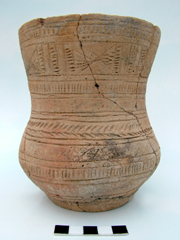
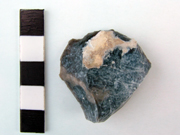
(XI)
North Foreland
Avenue 2004.
Excavation led by Paul Hart, Trust for Thanet Archaeology; (BNF04).
A 'Long-Necked' Beaker of Clarke’s (1970) DevelopedSouthern S2 series; Lanting
and Van der Waals'
(1972) Step 5 or 6.
From a roundbarrow containing the crouched inhumation burial of a woman at least in her 40’s; radiocarbon-dated to 2290-2190 BC (64.3%) / 2350-2130 BC (94.4%); (Wk 18732). The woman was placed on her left-hand side, facing south and probably laid within a coffin-structure. The Beaker was positioned at her feet.
A possible additional grave-good may be a rather utilitarian small end scraper, though this may be just a relatively contemporary discard. It was recovered from inside the skull.
There were also several important residual finds. A reworked Neolithic polished flint axe was recovered from the primary ditch fill. The grave fill also produced some locally rare Earlier Neolithic flintwork.
NGR 639916 169219.
TSMR 897.
Hart 2005.
Click here to link to a Display with more detailed information on this site.
Excavation led by Paul Hart, Trust for Thanet Archaeology; (BNF04).
A 'Long-Necked' Beaker of Clarke’s (1970) Developed
From a roundbarrow containing the crouched inhumation burial of a woman at least in her 40’s; radiocarbon-dated to 2290-2190 BC (64.3%) / 2350-2130 BC (94.4%); (Wk 18732). The woman was placed on her left-hand side, facing south and probably laid within a coffin-structure. The Beaker was positioned at her feet.
A possible additional grave-good may be a rather utilitarian small end scraper, though this may be just a relatively contemporary discard. It was recovered from inside the skull.
There were also several important residual finds. A reworked Neolithic polished flint axe was recovered from the primary ditch fill. The grave fill also produced some locally rare Earlier Neolithic flintwork.
NGR 639916 169219.
TSMR 897.
Hart 2005.
Click here to link to a Display with more detailed information on this site.
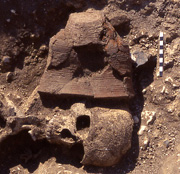
Photo by Susan Deacon (TTA)
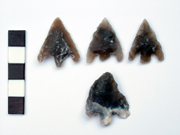
(XII)
Excavation led by Oliver Gardner and Ges Moody, Trust for Thanet Archaeology; (NAM05).
A ‘Bell Beaker’ of Clarke’s (1970) Wessex/Mid Rhine Group; Lanting and Van der Waals' (1972) Step 3.
From a large flat-grave containing a wooden coffin-structure which held the crouched inhumation of an adult male (possibly 40-50 years old), laid on his left-hand side, facing east. The Beaker was placed behind his head.
Alex Gibson suggested that conventional dating would place this vessel around 2300BC; the burial has produced a radiocarbon-date of 2350-2270 BC (37.6%) / 2460-2200 BC (95.4%); (Wk 18733).
Excavation led by Oliver Gardner and Ges Moody, Trust for Thanet Archaeology; (NAM05).
A ‘Bell Beaker’ of Clarke’s (1970) Wessex/Mid Rhine Group; Lanting and Van der Waals' (1972) Step 3.
From a large flat-grave containing a wooden coffin-structure which held the crouched inhumation of an adult male (possibly 40-50 years old), laid on his left-hand side, facing east. The Beaker was placed behind his head.
Alex Gibson suggested that conventional dating would place this vessel around 2300BC; the burial has produced a radiocarbon-date of 2350-2270 BC (37.6%) / 2460-2200 BC (95.4%); (Wk 18733).
Three barbed and tanged flint arrowheads were found behind his lower back. One of these is of Green Low type, which are largely associated with Southern Group Beakers. Green's research (1980) suggested that these arrowheads first appear with Step 4 Beakers (around 1850bc uncalibrated, circa 2200BC). The other arrowheads are of Conygar Hill type, which Green’s research showed do not normally occur with Beakers when in such finely finished form. They are more commonly associated with Food Vessels.
(NB. It should be noted that the three arrowheads do show minor variations from Green's classic type in some aspects of their barb or tang form; though in the case of the Conygar types the differences are particularly negligible).
The large primary grave-pit was backfilled with chalk (around the coffin-structure) and this was subsequently cut by the edge of a later pit which contained another crouched inhumation burial. The body was that of an adult female (possibly 25-35 years old), laid on her right-hand side, also facing east and accompanied by a crude barbed and tanged flint arrowhead of Sutton B type (found inside the skull).
NGR 636008 169432 (approximate).
TSMR 807.
Moody and Gardner 2005; Gardner and Moody et al 2006.
Click here to link to a Display with more detailed information on this site.
BM - British Museum.
TTA - Trust for Thanet Archaeology.
WK - University of Waikato.
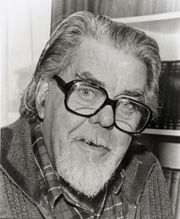
Len Jay
Photo by Dave Perkins
I would like to
express my grateful appreciation to the late Len Jay
(pictured left) who produced the first work on Thanet Beakers,
published in 1995.
Len's research is an
invaluable resource which has been
consulted extensively and provided the foundation for this summary. It included Beakers (I) to (IX) and (**) of
this current, revised list.
I am very grateful to Peter Clark,
Deputy Director of
Canterbury Archaeological Trust, for providing
information on the unpublished Monkton-Minster A253 burials and
allowing the Trust to see a draft copy of his discussion from the
forthcoming report
for comment.
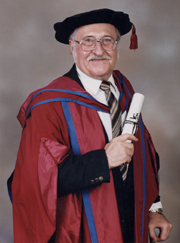
Dave Perkins
Photo by University of London
I would particularly like to acknowledge the work of the late Trevor Anderson, human bone specialist extraordinaire, who provided the specialist report on the burial from North Foreland 2004.
I should also like to thank Ellon Souter for introducing me to the grave-good from the Chalk Hill burial while at the Second Dover Bronze Age Boat Conference (2006). This has revealed it to be a jet belt ring rather than a shale button as originally described in the initial assessment report and thus earlier versions of this Display. It is hoped to get some pictures and more information on this object soon.
Finally, as with any study of Thanet's archaeological heritage a huge debt of gratitude is owed to the former Director of the Trust for Thanet Archaeology Dr. David Perkins (pictured left) for his labours in the excavation and analysis of the archaeology and history of Thanet.
Version 1 - Posted 09.04.06
Version 2 - Posted 17.05.06
Version 3 - Posted 13.06.06
Version 4 - Posted 21.07.06
Version 5 - Posted 25.07.06
Version 6 - Posted 16.12.06
All
content © Trust for Thanet Archaeology